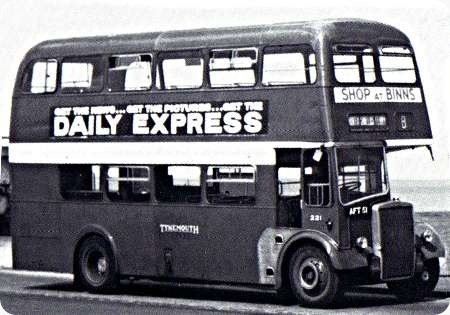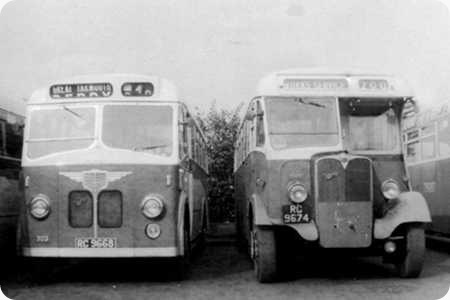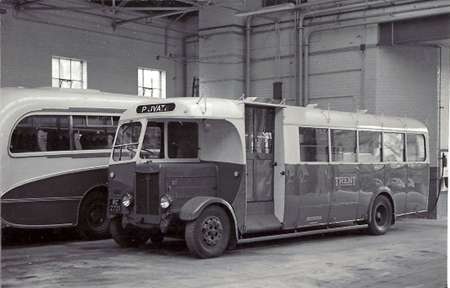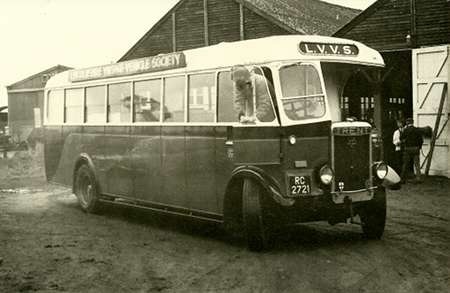
Copyright Ken Jones
Blue Bus Services
1939
Daimler COG5-40
Willowbrook C35F
GNU 750 is a Daimler COG5-40 (8485) with Willowbrook (3208) C35F body, and dates from 1939. It is preserved in the livery of Blue Bus Services (Tailby & George) who were based at Willington in Derbyshire. You’ll find more history on this company at Stephen Howarths website.
The above site includes this paragraph
Since the untimely deaths of their spouses in 1955 & 1958 respectively, the company had been run by Mr. Tailby & Mrs. George. Percy Tailby died in 1956 leaving Katherine George as sole proprietor until her death in 1965. Tailby & George Ltd. then passed to Douglas & Bunty Marshall, the latter being the daughter of the Tailbys. By the 1970’s public transport was in a state of serious decline. The railways had been decimated by Beeching and the majority of the bus industry was either nationalised (i.e. Trent) or in the hands of the local council, as in Derby and Burton. Small independent companies like Tailby & George faced fierce competition from the bigger companies. On 1st December 1973, the then proprietors of the company,
Mr. & Mrs. Marshall made the decision to retire. After much speculation the operation of the Blue Bus Service passed from Tailby & George Ltd to the Derby Corporation. 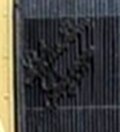
This vehicle was part of The Quantock Motors collection but Stephen Morris is down sizing and selling many of his vehicles. This one was for sale in June 2011 for £25,000. It has been sold to Lithuania. You can see pictures of it in Lithuania here //fotobus.msk.ru/ It appears that the coach will operate from central Kaunas to Urmas, which is a massive out of town shopping complex.
The above picture was taking in April 2010 when the vehicle was in service on the Quantock Motors gala weekend. It is seen at Bishop’s Lydeard entering the Quantock Motors site. Note the Blue Bus Services badge on the radiator.
Photograph Ken Jones, Copy Ken Jones & Stephen Howarth
25/01/13 – 06:59
What a gem. For English on the link, press the little union flag top right.
Joe
25/01/13 – 09:48
What a beautiful coach. Strange, though, that it only had the 5-cylinder Gardner engine. I wish it well in Lithuania, but admit to some qualms about such loving care being lavished on it. Fingers crossed!
Chris Hebbron
25/01/13 – 12:36
The CVD6 was the most common post-war coach, and then the CVG6. How common was the COG6 before the war, though? Until the Regent III/PD2 era, the 7 litre 5LW was thought adequate for single deckers. Only Tilling parsimony allowed the 5LW to flourish after the war.
David Oldfield
25/01/13 – 14:58
It seems a shame that this gem as Joe calls it is no longer in the country where I presume it spent the last sixty odd years, another loss to the UK.
Very nice shot by the way, never seen that done with a bus before.
Trevor Knowles
25/01/13 – 17:27
A couple of other shots of this coach may be found in the 1968 Halifax Parade gallery, when the livery was slightly different. The 8.6 litre Daimler CD6 engine proved to be less than dependable for double deck work, and became instead the standard option for CV saloons up to the early 1950s. Post WW2, the 5LW engine was certainly not restricted to Bristol buses. Daimler offered a CVG5 variant which was taken by several operators. The 5LW was specified for many Guy Arab III machines, single and double deck, and it appeared in Dennis and Tilling Stevens buses also. In addition, this engine was offered in several makes of goods chassis, and for marine and industrial purposes. The 5LW did not depend upon Bristol for its post war survival. In its final form as the 5LW/20 it developed 100bhp at 1700 rpm, though, by that time, it was no longer offered in bus chassis.
Roger Cox
26/01/13 – 06:44
Bullocks of Featherstone (B&S Motor Services) – taken over by West Riding in 1950 – had five of this identical model Daimler (COG5/40), but managed to squeeze 39 seats into their Willowbrook bodies. The first, BWW 475 (202) was in fact a 1936/37 Commercial Show model. They were fine vehicles spoilt by the somewhat excessive engine vibration which necessitated body rebuilds after the war.
David Allen
26/01/13 – 06:45
Bodywork was generally lighter before the war than after, and the COG5 was Daimler’s most popular model for both single and double deck vehicles. Manchester’s COG5 double deckers were very successful, and so unsurprisingly their first postwar Daimlers were CVG5s. But with an unladen weight of around 8 tons these were less satisfactory, so CVG6s were then purchased until lighter bodywork became available in the mid-fifties (together with some lightweight chassis features arising from the development of the CLG5). CVG5s were then tried again, but were beaten by changed traffic conditions, so MCTD reverted to six-cylinder engines for the final batches.
Peter Williamson
Michael Elliott
GNU 750 as an example of the COG5-40 had a more compact engine compartment and cab that the standard COG5. The 40 in the designation denoted the ability to accommodate 40 passengers. GNU also had a five speed gearbox. I drove this bus on several occasions during the early 1970s when it was in the ownership of John Horrocks.
Michael Elliott
26/01/13 – 13:57
This is a very interesting view, Ken – thanks for posting. It reminds me of the "selective" tinting of school photographs in my primary school days. They were taken in black and white but could be enhanced on payment of a supplement.
I’ve heard of – but don’t use – Photoshop. Is that program how you achieved this?
Pete Davies
26/01/13 – 15:47
There are several programs that will do this sort of task, Pete. Photoshop is the top of the range product for professional artshops and advertising agencies, and is extremely expensive – around £600. Cheaper alternatives are available, including Photoshop Elements and a free program called GIMP. I have an old Photoshop version and also the latest Serif Photoplus X6, which will do most of the things that most of us will need.
Roger Cox
27/01/13 – 08:06
Thanks for that, Roger. The program I use came with the slide scanner I bought a few years ago when converting my slides to digital. It’s called Photoimpression 6. I still use it for editing the digital photos: no point in buying one when I have one in hand!
Pete Davies
27/01/13 – 08:07
Or you could download the free program Photofiltre or use online photo editor Sumopaint, Pete.
Chris Hebbron
04/02/13 – 11:52
I was present on the 1st of May for this running day at Bishops Lydeard and was delighted to see GNU 750 being started up and brought into the ‘bus station’. The run went to Hestercombe House and Gardens but most of the gentlemen aboard (some eight or so of us) preferred to stand around the coach rather than visit the house and gardens.

There was some playing around with the destination indicator and, as my photograph shows, some details of the coach were displayed. Would it have been usual practice – by Daimler, if no-one else – to include such information at the beginning or end of their destination rolls? Much as I enjoyed the run, a ride on the ex-Royal Blue Bristol L coach HOD 30 a little later proved to be a more luxurious affair.
Berwyn Prys Jones
05/02/13 – 07:05
The Daimler message on the destination blind will almost certainly have been added during preservation. In any case, the destination blind would not have been provided by Daimler, who only built the chassis.
Mention of "GNU 750 being started up" takes me back to Battersea Park May 1969, prior to the start of the HCVC London to Brighton run. GNU’s chief supporters were up bright and early, sprucing and polishing. I was tasked with taking the ‘tender vehicle’, ex Samuel Ledgard 2-stroke Foden ONW 2, across the bridge to pick up the rest of the party from their hotel. The only problem was that ONW’s exhaust pipe was pointing straight at the now gleaming GNU, and a cold start in that position would have resulted in a large deposit of soot! So GNU had to be started up and moved out of the way first. Funny how things stick in the mind.
Peter Williamson
05/02/13 – 17:42
A couple of shots of Foden ONW 2 may be seen on the ‘Halifax Parade 1968’ gallery. Sadly, this interesting vehicle has since fallen victim to the breaker’s torch.
Roger Cox
07/02/13 – 17:03
Thanks, Peter, I half-suspected as much, but hadn’t seen anything like it on the other preserved buses in the Stephen Morris collection. One wonders why it was put there and only there.
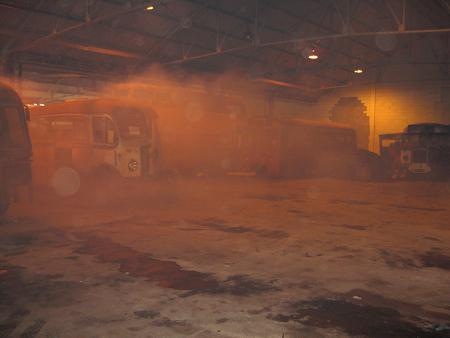
You mentioned starting up. I happened to be inside the depot when another of the Stephen Morris collection was being fired up (almost literally). Just out of sight, a driver had started the engine of the lovely ex-East Kent Leyland Tiger. The whole of the southern half of the shed was gradually enveloped in a fog of white dust (photo attached). As there was no wind, the dust hung round the place creating a rather eerie atmosphere with only the noise of the Tiger’s engine to remind me that I hadn’t been transported to an unhealthy underworld somewhere …
Berwyn Prys Jones
08/02/13 – 06:45
This picture reminds me of Percy Main depot on winter mornings. The garage staff had a cold start technique that required two men and a diesel soaked rag tightly wrapped around a stout piece of wood. The rag would be set alight, one of the staff would then turn over the engine while the other would hold the lighted rag at the end of the canister like air filter. Gardener engines are notoriously smoky when cold, and when you have several of them ticking over at once, the exhaust fumes would be billowing out of the open garage doors giving many a passer by the impression that the place was on fire.
Ronnie Hoye
08/02/13 – 09:07
I recall, in the early ’60’s, going on a fortnight’s course in Brum and staying in digs next to Harborne Depot. Come 4.45am, every morning, there would be the cacophony of bus engines being started, ticking over, then driving out. It’s a wonder I ever succeeded at the course with lack of sleep! I lived near a trolleybus depot for some years – what bliss!
Chris Hebbron
08/02/13 – 16:23
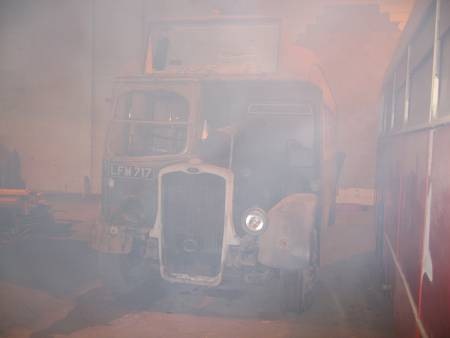
At the risk of going severely ‘off piste’, this photo of an ex-Crosville L parked just to the right of the vehicles in my previous photo may evoke the atmosphere at the depot even more vividly.
Berwyn Prys Jones
10/02/13 – 07:45
Berwyn, GNU 750 has been in preservation for a long time under several owners. Here it is in 1979 with the same blind. www.flickr.com/photos
Peter Williamson
08/12/17 – 07:08
In 2011 bought by private person and exported to Kaunas city, Lithuania: //busphoto.ru/photo/209576/
Andrejs
09/12/17 – 07:33
A nice photograph Andrejs but I note that it’s dated 2014. I wonder if the vehicle looks the same now!
Chris Barker
